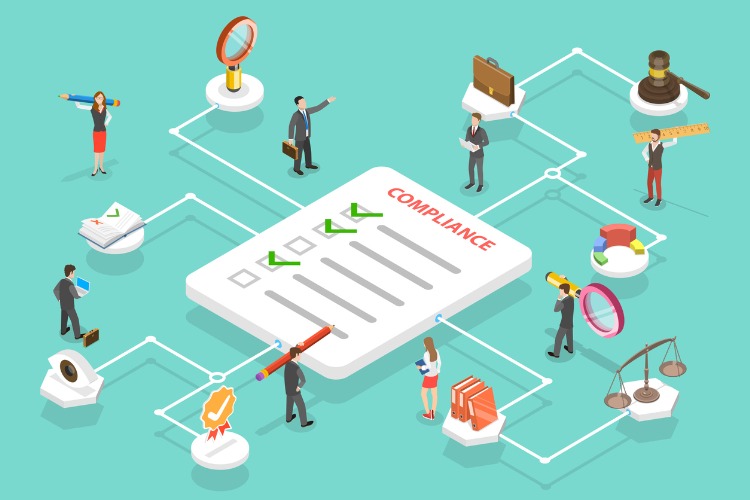Using Technology to Keep Compliance Costs Down
Regulatory compliance is overwhelming for any company without the right tools. Think of multinational financial firms that have to comply with laws in multiple jurisdictions where they operate.
Of course, regulatory compliance is costly – making it a concern for the business community. As per Deloitte survey, CFOs based in North America rated burdensome regulation as a serious threat to their business, second only to a possible recession. In Australia, the red-tape costs approximately AU$176 billion per annum, which accounts for 11% of the nation's GDP. In Canada, regulatory compliance costs approximately 5X higher for smaller businesses than for larger ones.
Thus, as various governments continue to implement programs to lower regulatory burdens on businesses, company leaders know there's a need to cut down on regulatory compliance costs. Luckily, technology can help cut compliance expenses without cutting regulations-related oversights and protection – as described below.
#1: Technology and Increased Internal Efficiency
Operational challenges such as backlogs and resource constraints can interfere with compliance processes and, as a result, lead to expensive fines. With technology, however, a business can:
Automate manual tasks
Regulatory compliance often involves large amounts of paperwork and repetitive yet labor-intensive tasks. Technology such as RPA can help fill out time-intensive compliance forms, hence, saving time, labor, and their associated costs. Besides, automation helps the compliance team to focus on critical tasks.
To paint a picture: On extensively analyzing the US federal government workforce, Deloitte estimated the automation of manual tasks to free-up approximately 60 million hours/year spent in regulatory compliance, consequently lowering the associated cost of staff and resources.
Optimizing enforcement efforts
Large businesses comprise of many running systems, from financial to legal departments. As such, it can be expensive for their compliance officers to ensure full regulatory compliance – especially with the increasing areas in need of regulatory compliance and the changing regulation trends coupled with limited resources.
Machine learning and predictive data analytics can, therefore, come into play to help these officers prioritize which areas to inspect and enforce regulatory compliance. CTOs can use data analytics to predict what departments in the multinational firm are likely to default regulatory compliance. Alternatively, they can use AI-based technologies to develop algorithms to measure risks across different dimensions and factors, allowing the compliance officers to address high-risk compliance issues first. That will, in turn, lead to efficient use of time and resources.
#2: Technology and Improved Regulatory Effectiveness
Along with technological advancements come a change in laws and regulations governing businesses. These disruptions can prove costly for companies caught off-guard. Luckily, technology can help CTOs and CCOs to identify patterns in large volumes of data, foresee future developments, and anticipate potential compliance problems before they occur. With technology, businesses can:
“Sense” disruption and associated problems
New business models, innovative technologies, and their associated regulations can catch compliance officers off-guard. Without the means to sense emerging treads, compliance teams risk falling behind the game.
With crowdsourcing, however, company heads can often tap into the crowd‘s knowledge to stay ahead of possible disruptive trends in their industry. They can also use AI-based text-mining and data analytics techniques to understand potential innovations and their associated consequences to business laws and regulations. In addition, compliance officers (with the help of the technology team, of course) can use AI-algorithms to model the laws and regulations needed when the impeding disruption becomes widespread.
The results? Staying ahead of the curve can help prevent destabilization and its associated costs.
Fighting fraud
Regulatory compliance faces false data, identity fraud, among other challenges. Given the hefty fines associated herewith, CTOs can leverage technology to detect these frauds without going over budget.
For instance, they can use social-proof nudges to help various departments benchmark their regulatory compliance against others. The goal here is to encourage changes for the better – and encourage different teams to report accurate information. Alternatively, they can use machine learning to identify false data or use network and data analytics techniques to detect identity fraud.
Rethinking outreach
Given their role in innovation, CTOs can use technology to facilitate earlier dialogues with governments and other regulators before their disruptive innovations “go live.” Technology eases interactions with different stakeholders at a scale, helping them reach a consensus on specific-innovation regulations - quickly. Following business participation, the resulting laws can be (somewhat) reasonable and less burdening.
#3: Technology and Reduced Regulatory Compliance Burden
Businesses are required to acquire permits & licenses, pay fees, pass inspections, and comply with other laws and regulations. To make these transactions painless; businesses can:
Integrate data systems
Integrating data systems can help businesses produce more granular information for regulators at higher frequencies. Data integration saves time & effort while providing full traceability from submissions back to the data source. It will also eliminate any limitations in scalability and extensibility associated with the manual compliance methods. Also, businesses can use IoT technologies to create more-connected access to compliance data – all while getting valuable insights into their businesses.
Given the large volumes of data collected in the process, businesses can utilize website archiving to store their inactive information for long periods - safely. Website archiving will also help these businesses to control and manage their data. It also prevents data loss and increases security while capturing and securely-storing legally admissible and on-demand records. That will, in turn, reduce any associated costs.
Written February 2021 by Reciprocity: Reciprocity’s mission is to turn corporate compliance from a cost center into a valuable strategic asset. We make compliance and risk officers more nimble with lightweight software designed for hot-growing companies. Our Governance, Risk and Compliance (GRC) Software encourages compliance, risk and audit managers to act more nimbly and stand toe-to-toe with the fast-paced world of business.

